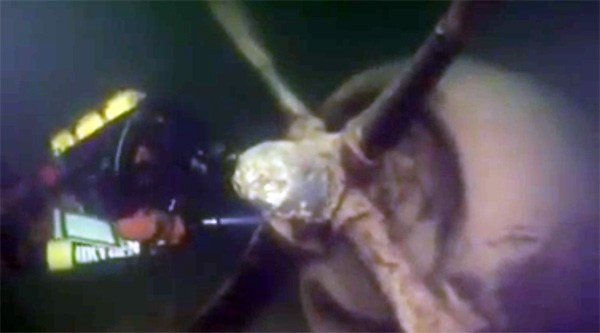
Photo courtesy of the National Parks Service
Beginning in the summer of 2015, divers will once again be able to dive and explore the wreckage of a World-War II bomber at the bottom of Lake Mead in Nevada.
The B-29 bomber, which crashed into the lake on July 21, 1948 during a training mission, was rediscovered in 2001 by a team of local divers. Archeologists from the National Parks Service mapped and documented the wreck site, and in 2006, the Parks Service awarded permits to two dive companies to guide technical dives on the wreck. At that time, the wreckage was 160 feet down; a recent drop in water levels has reduced that depth to about 110 feet, and its now within recreational diving depth. In 2009, those permits were not renewed, and dive companies were unable to turn a profit from offering the dive excursions to the wreck. Diving the site also required companies to comply with many restrictions.
The wreckage is located in the Overton Arm of Lake Mead, though precise coordinates are kept under wraps to protect it. The wreck is considered an archeological site and removing anything from it is a violation of federal law.
The National Parks service is now accepting bids from dive companies who are interested in offering guided dives of the B-29. Permit applications for potential B-29 tour operators are available by visiting the National Park Service here: www.nps.gov/lake/parknews/b-29-permit.htm. Note that the deadline to apply is January 23, 2015.
A Brief History of the B-29
According to the National Oceanic and Atmospheric Administration, the B-29 that crashed into Lake Mead was one of the last built, and was delivered to the U.S. Army just 11 days after the end of World War II. It had it’s armaments removed and was serving as a research and reconnaissance plane. At the time it crashed, the bomber was on a mission to test a secret missile guidance system.
While flying low over the lake on a calm and crystal-clear day, the pilot lost his his sense of depth perception and the bomber hit the water at a speed of 230mph. It skipped once then settled on the surface before sinking. All of the crew survived.
The B-29 is an impressive site underwater, even though it has deteriorated with age. It measures 99 feet long and has a wingspan of 140 feet. Inside the cockpit windows, tool kits, an open parachute, and oxygen tanks are still visible. The wreck is now covered with silt and invasive quagga mussels.
